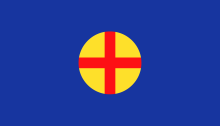Sun cross
This article needs additional citations for verification. (June 2007) |

The sun cross or Bolgar cross, more commonly known as the sun wheel, a cross inside a circle, is a common symbol in artefacts of Prehistoric Europe, particularly during the Neolithic to Bronze Age periods.
Stone Age
Crossed circles scratched on stones have been recovered from Paleolithic cave sites in the Pyrenees.[citation needed]
At the Callanish Stones in the Outer Hebrides, the most famous megalithic site in Scotland, crossing avenues of standing stones extend from a circle. Scratched into stone or painted on pottery, as on that of the Samara culture, the crossed-circle symbol appears in such diverse areas as the Pyrenees, Anatolia, Mesopotamia, the Iranian plateau, and the cities of Mohenjo-daro and Harappa in the Indus River valley.[citation needed]
Bronze Age Europe
In the prehistoric religion of Bronze Age Europe, crosses in circles appear frequently on artifacts identified as cult items, for example the "miniature standard" with an amber inlay that shows a cross shape when held against the light, dating to the Nordic Bronze Age, held at the National Museum of Denmark, Copenhagen.[1] The Bronze Age symbol has also been connected with the spoked chariot wheel, which at the time was four-spoked (compare the Linear B ideogram 243 "wheel" 𐃏.) This technological innovation reached Europe in the mid-2nd millennium BC. In the context of a culture that celebrated the Sun chariot, it may also have had a "solar" connotation.
-
Wheel pendants dating to the second half of the 2nd millennium BC, found in Zürich, are held at the Swiss National Museum. Variants include a six-spoked wheel, a central empty circle, and a second circle with twelve spokes surrounding one of four spokes.
-
Ornamental pins, found in Switzerland, date to the first half of the 2nd millennium BC; their circular heads are incised with crosses.
Sun cross in culture




Astronomy
An identical astronomical symbol represents the Earth, while the Sun is symbolized by a circle with a central dot.
Ethnography
The sun cross is used to represent the Indo-European peoples.
Contemporary Amerindian and other indigenous peoples continued to use the sun cross in symbolic practice and decoration.
Music
In modern music tablature the sun cross can denote a change of guitar from an acoustic tone to a Distortion tone. [2].
Politics
The Sassanian Empire which is called Eran Shahr (Aryan Empire) in Middle Persian [3], used a symbol similar to the sun cross on its vexilloid, the Derafsh Kaviani. [4][5]
The Norwegian Nazi party Nasjonal Samling used a golden sun cross on a red background as its official symbol from 1933 until 1945. The cross within a circle was ascribed to Saint Olaf, the patron saint of Norway, and the colours were those of the coat of arms of Norway.
Various white nationalist and Neo-Nazi groups use the sun cross to represent the white race, i.e., the Western or European branch of the Indo-European peoples.
Religion
In Wicca the sun cross most commonly represents the sun and the four quadrants the wheel of the year, i.e. the four seasonal cycles of the year.
Along with other ancient symbols, Pagans use the sun cross in practicing a reconstruction of ancient Celtic, Germanic and Slavic pre-Christian religion and culture.
It has been claimed[6] (but also denied[7]) that the Celtic cross was originated by combining the sun cross with the plain Christian cross. See Celtic cross.
In the Ascended Master Teachings, a group of religions based on Theosophy, the most important deities are St. Germain and the Master Jesus. St. Germain is regarded as having a twin flame (divine complement or celestial wife) who is an ascended lady master named Portia. In iconography of the Lady Master Portia, she is shown as wearing around her neck a white sun cross with a violet background, since she works with St. Germain, who is regarded as the master of the seventh of the seven rays, the violet ray. [8]
See also
- Solar symbol
- Christian cross or Crucifix
- Labarum or Chi-Rho
- Brigid's cross, also Celtic cross
- Solar deity, also Sol Invictus
- Taranis
- Swastika
- Ankh
- Lauburu
- Medicine wheel
- Wheel of the Year
- Zierscheibe
- Black Sun (occult symbol)
- Irminsul
- Maypole
References
- ^ entry at the Nebra sky disk exhibition site (landesmuseum-fuer-vorgeschichte-halle.de)
- ^ www.ultimate-guitar.com
- ^ Wiesehofer, Joseph Ancient Persia New York:1996 I.B. Tauris
- ^ Website honoring Dr. Kourosh Aryamanesh—Depicts images of the Derafsh Kaviani:
- ^ Image of the Derafsh Kaviani:
- ^ Stephen Walker, "Celtic Cross History and Symbolism", Celtic Arts website, accessed 22 Nov 2008
- ^ Werner, Martin (1990). "On the Origins of the Form of the Irish High Cross". Gresta. 29 (1): 98–110. Retrieved 2009-05-22.
{{cite journal}}: Cite has empty unknown parameter:|month=(help) - ^ [http://www.innerlightworkers.co.uk/ascendedmasters/mastersmep.htm Image of the Lady Master Portia, twin flame (celestial wife) of St. Germain (her image is at the end of the "P" section, at the bottom of the web page):]
External links
- Celtic Sun Cross Meanings and History.
- Symbolism of sun cross (symbols.com)


